Strange are the manuscripts of this Friend, great traveler of the
unknown.
I think that these “manuscripts” represent the wisdom of the
tablet
of Enoch (Hermes-Thoth). It is Enoch, as Noah,
Deucalion, or Hercules, who is the
“great traveler of the unknown.” Hercules is mentioned later in the
poem, and his tomb is said to be located in a cave within Montsegur.
He was the pilot of the boat called the “Cup of Helios” (the
“Sun-ark”). That would make Hercules (also called “Arkaleus”)
another manifestation of the archetype of Noah (whom I have
identified as being the same as Enoch). Hercules is famous for
enduring a series of twelve trials, all of which clearly represent
the houses of the zodiac. Le Serpent Rouge may be presenting us with
a strange allegory for the Labors of Hercules: one in which there
are thirteen trials, and thirteen zodiac houses, instead of twelve.
The “unknown” through which he travels, then, would be the zodiac -
the Celestial Sea, also represented by the serpent.
They reached me separately, nevertheless they form a whole for him
who knows that the colors of the rainbow give a white unity, or for
the Artist, who, under his brush, is able to, from the six hues of
his magic palette, make the night spurt out.
This passage refers to the peculiar property of the seven colors of
visible light, which, when combined, form a pure white light, the
radiance of divine illumination. This may be an allusion to the
alchemical language of light. When all of the major pigment colors
are added together, they form the opposite - black. The Grail has
always symbolized, in part, the essential unity of diverse aspects
of the universe in this manner, including the unity of opposites
such as black and white. The author of this poem seems to be saying
that that Grail has been broken into disconnected pieces and
scattered about, like the pieces of Osiris’ body, or the original
language of the Tower of Babel.
This friend, how does one present him? His name remains a mystery,
but his number is that of a famous seal.
“His name remains a mystery” because the true
Enoch is hidden behind
many veils of myth, and is given many names. The “seal” is the
six-pointed seal of Solomon, which is associated in the occult with
Saturn (Satan). I have discussed in other articles, and in The
Merovingian Mythos, how this symbol also represents the “Arka” and
the world-mountain.
How does one describe him? Maybe like the pilot of the imperishable
Ark...
A direct reference linking the main character to
the Flood hero.
… impassable like a column on a white rock, scanning towards the
South, where the black rock is.
Here we have a reference to a
white rock and a black rock. The Grail
stone is said to be both white and black, and this will have a very
particular significance later on in the poem.(1) The Ark’s pilot
standing “impassable” upon the white rock may also refer to the
mountain that the Ark rested upon when the Flood subsided, like Mount Ararat in the Bible.
In my arduous pilgrimage, I was tempted to clear for myself, with a
sword, a way towards the inextricable vegetation of the woods. I
wanted the reach the mysterious house of the Sleeping BEAUTY in whom
certain poets see the QUEEN of a fallen kingdom.
This describes the “Herculean” task of finding the tomb of the
goddess-queen said to be buried in the Pyrenees. She embodies the
goddess archetype of Venus, the Sleeping Beauty. The symbols of the
labyrinth and the dense woods are identical and are often combined
in other versions of the Tomb of Venus tale. Nicholas de Vere writes
in
The Dragon Legacy that,
“Labyrinths were often placed in the
center of groves. Sleeping Beauty, Diana and Rapunzel’s tower were
all located in the middle of groves or thick woods.”
And as the poem
says, Venus was indeed a queen during the golden age. That kingdom
is now “fallen”, and it is that “fallen kingdom” which the
Priory of Sion wishes to revive.
Worried about finding the way again, the parchments of this Friend
were for me like the thread of Ariadne.
Here we have a direct reference to the aforementioned labyrinth,
specifically the one built on Crete which is the center of the
famous Greek myth of Theseus and the Minotaur. This labyrinth symbol
repeatedly comes up in connection to the Venus myth and the Holy
Grail. The labyrinth is often located inside the caverns of Venus’s
enchanted mountain, or, as in the Rapunzel story, can be entered
through a tower that represents a mountain. In fact in Scandinavia
labyrinths are referred to as “Babylons”, indicating that perhaps a
labyrinth was located underneath the Tower of Babel, like the
labyrinths that have been found underneath South American ziggurats
and the pyramids of Egypt. There may then be one underneath the
mountains of Rennes-le-Chateau. As Nicholas de Vere states,
“The
labyrinth, like the pyramid and its collaterals, is thought to be a
development of the idea of the mountain cave.”
De Vere also sees the labyrinths as a feminine, vaginal symbol, and
the Sleeping Beauty story as a metaphor for sex magic. He points out
that the word “labyrinth” very likely comes from “labia”, and that,
“On at least two occasions in England labyrinths have been
euphemistically referred to as ‘fishtraps’”, bringing to mind not
only a vaginal connotation, but one specifically associated with
Venus, who was represented in myth by the fish, and who came from a
race of “navigators”, all of whom were associated with fish and
water. In some versions of the myth of the Melusine - that
half-woman, half-fish who was the spawn of Satan (clearly a
representation of the Venus archetype), and who spawned the Angevin
kings - de Vere says that Melusine is depicted as residing in the
midst of a labyrinth.
“The center of the maze”, he writes,
“incorporated a black cubic stone, from which spurted the waters of
life, La Fontaine de Soif, and the blood of the Virgin Womb.”
This
relates to de Vere’s theory that the Grail kings of the ancient
world regularly participated in a vampiric ritual that involved
drinking the menstrual blood and female ejaculate of so-called
“Grail maidens”, the foremost of which was Venus herself, “the Queen
of Harlots”, and head of the temple prostitutes.
This ritual would have been cause itself for the Grail kings to
observe a 364-day lunar calendar based on thirteen lunar (and
menstrual) cycles of twenty-eight days each. Such a calendar would
seem to be represented by the labyrinth on the floor of the Chartres
Cathedral in France, of which de Vere writes that,
“The radius of
the maze is 21 feet, which is 3 x 7, representing the three fallow
weeks of the menstrual cycle. The week of menstruus would be
represented by the point at the center of the maze, which is, on
certain days, illuminated red.”
This is accomplished by use of a
stained glass window through which sunlight shines upon the center
of the maze. Here also can be found, according to de Vere, a
“six-petaled Plantagenet or wild rose, carved into which there seems
to be an M figure reminiscent of the symbol of Virgo.”
In the myth of the Minotaur, the thread of Ariadne is what allowed
Theseus to escape from the Labyrinth after slaying the beast. Every
nine years, the Minotaur required a sacrifice of seven youths and
seven virgins, who were placed as hapless victims inside the
labyrinth, where they were torn apart and eaten by the monster. This
state of affairs is what Theseus was sent to rectify by slaying the
monster. As de Vere writes,
“...by the time Theseus is said to have
turned up, the tribute to the Minotaur in youths’ and virgins’ blood
had been paid twice in 18 years. Gematrically this gives us a total
of 28 victims, on one lunar cycle of 28 days.”
Ariadne, while depicted as human in some versions of the tale, would
appear to represent a spider who spins a magic thread. Note the
similarity between the name of “Ariadne” and that of “Arachne”,
from whence we get the word “arachnid”, denoting an eight-legged
creature, such as a spider.(2)
Arachne was a Greek goddess, the
master spinstress of Olympia, who hanged herself after she lost a
web-spinning contest to the goddess Minerva. Her competitor then
felt sorry for her, and reincarnated her in the form of a spider.
This web-spinning goddess figure would seem to have a link to
Sleeping Beauty, who, if you will recall, fell into a deathless
sleep after pricking her finger on an enchanted spinning wheel. Theseus entered the labyrinth with the magic thread of Ariadne tied
around his waist, like the cable tow of the Freemasons that is worn
while “groping for light” (akin to traversing a labyrinth) during
their initiation ceremonies. De Vere compares the story to that of
Rapunzel, writing that,
“In Rapunzel the golden thread is her hair,
and the maze is substituted by the equally daunting but related
structure, a Tower.”
Thanks to him, from now on with measured steps and with a certain
eye, I can discover the sixty-four dispersed stones of the perfect
cube…
The “sixty-four dispersed stones” which form a “perfect cube” must
be a crucial part of this mystery. There are sixty-four squares on a
chessboard, and a perfect sixty-four-square chessboard is formed by
the black and white tiles on the floor of the church at
Rennes-le-Chateau, facing both the statue of the demon Asmodeus, and
the statue of Saint Germain, as if they were opposing players in a
game of chess. In addition, the cipher used in one of the Sauniere
parchments is based upon the chessboard, specifically the “Knight’s
Tour.” This is a mathematical puzzle, to which there are numerous
solutions, the goal of which is to have the knight visit each square
on the chessboard once only, using the L-shaped knight’s move. The
Knight’s Tour was also used to form the encryption system used in
the code found on one of Sauniere’s parchments.
The chequered pattern, and the game of chess itself, is associated
with the Knights Templar, who purportedly acquired knowledge of
these things through their extensive contact with Eastern mystics
during the Crusades. The game of chess not only represents the
eternal battle between the forces of good and evil, light and dark;
it also represents something astrological. First of all, the board’s
outer ring consists of twenty-eight squares, which, as Michael
Schneider acknowledges in The Beginner’s Guide to Constructing the
Universe, represents the twenty-eight days of the lunar cycle. The
king and queen are solar and lunar symbols, as Schneider elaborates:
“The king, the most important piece, represents the Sun of this
solar system... traveling only one step at a time, along both square
and triangular lines, in any of eight directions. The king is
virtually hidden from the action, yet the entire game revolves
around it...The queen is the most powerful piece on the board,
having unlimited movement in any of eight directions of
manifestation... In another sense she is Regina Coeli, Queen of the
Heavens, the widely traveling moon which always reflects the light
of the Sun, the king.”
Besides the king and queen, other pieces on the board also have
special significance. The four rooks, or towers could represent the
“four watchtowers” that divide the zodiac into four cardinal points,
and which were incorporated into the headdress of the goddesses Isis
and Diana, as well as Mary Magdalene. (In fact, a statue of Mary
Magdalene crowned with four towers can be seen just outside in the
courtyard of the church at Rennes-le-Chateau.) The black and white
squares could be considered alternating periods of day and night.
The chessboard itself, made up of four concentric rings of squares,
resembles a “bird’s eye view” of a four-stepped ziggurat, and thus
represents the world mountain that in the eyes of the ancients
provided the axis along which the cosmos metaphorically rotated.
In the belief system of ancient man, it was the cosmos, and the
heavenly bodies contained within it, that controlled man’s fate. The
chessboard symbolizes an astrological mosaic of fate’s
possibilities. On the board there are six different types of pieces,
and these six types of pieces can move in any of eight directions
(the four cardinal points, and the four diagonal points). That there
are sixty-four possibilities is fitting, since there are sixty-four
six-part “codons”, or “genetic words” in human DNA. There are also,
notably, sixty-four hexagrams in the Chinese divination system known
as I-Ching. The relationships between the pieces on the chessboard
form, as Michael Schneider suggests, “...lines of force composing an
energy web”, like the web of the spider goddess Arachne, whose eight
legs can be likened to the eight directions on a chessboard, as well
as the eight squares that are on each side of the chessboard’s outer
ring.
Schneider writes that,
“The chessboard, the spider’s web...
and the I-Ching each in its own way represents the world’s opposite
forces weaving the eight-fold ‘elements’... the warp and weft of
matter’s web.”
The Web of Arachne, or the “Web of Fate”, was also
likened by Nicholas de Vere to the Buddhist eight-spoked Wheel of
Life, and to the Tarot’s eight-spoked Wheel of Fortune, which both
seem, in this context, to be not unlike Sleeping Beauty’s spinning
wheel, which controlled the fate of an entire kingdom.
There is another important connection as well. I have discussed in
my book The Merovingian Mythos how the Egyptian symbols of the
Eye
of Ra and the Eye of Horus represent the “Grail stone”, the “stone
that was rejected” and the “substitute” stone. Well, according to
R.T. Rundle Clark’s Myth and Symbol in Ancient Egypt, the Eye of Horus consists of “64 parts” that have been scattered and need to be
reassembled! He writes:
“It will soon be seen that if each part of the [Eye of Horus]
represents a fraction of the descending geometric series 1/2, ¼,
1/8, etc., put together, they make 63/64… So Thoth (3) can say ‘I
came seeking the Eye of Horus, that I might bring it back and count
it!’”
The Eye of Horus is a representation of the Grail stone as the
“All-Seeing Eye” of Satan, with which all of his direct descendants
are able to see as well. This would have to be the “Third Eye” of
Hinduism, called the “Ajna” (which comes from “Az”, a title used by
both Cain and Enoch). Is this, then the “certain eye” which
discovers the “sixty-four dispersed stones of the perfect cube”?
The “perfect cube” is also an important symbol in the ancient
mysteries, being representative of the “Philosopher’s Stone” of the
alchemists. Albert Pike wrote that the Emerald Tablet was a cube.
The cube contains, in its angles, magic numbers. As Pike wrote:
“If we delineate a cube on a plane surface thus, we have visible 3
faces, and 9 external lines, drawn between 7 points. The complete
cube has 3 more faces, making 6; 3 more lines, making 12; and 1 more
point, making 8. As the number 12 includes the sacred numbers 3, 5,
and 7, and 3 times 3, or 9, and 3 times 3, or 9, and is produced by
adding the sacred number 3 to 9, while its own two figures, 1,2, the
unit, or monad, and duad, added together, make the sacred number 3;
it was called the perfect number; and the cube became the symbol of
perfection.” (4)
The “scattered stones” of the cube mentioned in this poem may also
refer to the ruined Temple of Solomon, a building whose dimensions,
delineated to the architects specifically by “God” himself, formed a
perfect cube. Albert Pike writes of this:
“The Holy of Holies of the
temple formed a cube, in which, drawn on a plane surface, there are
4+3+2=9 lines visible, and three sides or faces...”
Perhaps this is
why the unit of measurement used by the Hebrews for the construction
of the Temple was called, by Englishmen, the “cubit.”
Given what we know, we can now look at one of the mysteries
surrounding Jean Cocteau, the presumed author of the poem Le Serpent
Rouge, with fresh insight. In the mural he created at the Notre Dame
de France in London, he signed his name with the mysterious initials
“D.D.D.” - a code which has never been explained. But if you
consider that “D” is the fourth letter of the alphabet, and then
cube the number 4 (4 x 4 x 4, or 4 to the third power), you get 64
- a perfect cube.(5)
… that the Brothers of the BEAUTY of the black woods, escaping the
usurpers pursuing them, disseminated while they were fleeing the
white Fort.
If the “beauty” is Isis, or Venus, then her “brothers” are the
Cainites (descendants of Cain), who literally were her brothers.
Also note that there is a woman whose grave, located on the grounds
of the church at Rennes-le-Chateau, is very important to the whole
mystery, and whose name, “Marie de Blanchefort”, means literally,
“Marie of the White Fort.” Clearly her grave stone, and her name,
are clues pointing to the grave of Venus, the real “Marie of the
White Fort.”
Reassemble the scattered stones, and work with square and compass to
put them back in regular order;
The Freemasons’ most well-known emblem is the
L-shaped, right-angled
square and compass, and this reassembly of “scattered stones”
indicates re-acquiring “that which was lost”, i.e., the Grail stone,
by using the L-shaped, right-angled moves of the knight in the
Knight’s Tour to “reassemble the scattered stones.”
…search for the line of the meridian that goes from the Orient to
the Occident, then look from the South to the North, and finally in
every direction to obtain the sought solution, stationing oneself
before the fourteen stones marked with a cross.
This indicates using the “Roseline” meridian that, according to the
Priory of Sion and Pierre Plantard, runs through
Rennes-le-Chateau,
and which is a much more ancient meridian than even the Paris
meridian, supposedly. It has been suggested that the “fourteen
stones marked with a cross” may actually refer to the fourteen
Stations of the Cross within the church, each of which is surmounted
by a Celtic-style cross with a circle. However, I am not certain
that this is the correct interpretation.
The circle was the ring and the crown, and that was the diadem of
this QUEEN of the castle.
This passage associates the Venus figure with the written symbol of
Venus: a cross surmounted by a circle - the queen crowned. This sign
is related to the Celtic cross mentioned above, and to the Egyptian
Ankh, which was also used by
the Cathars, who referred to it as “the Albigensian cross.” This imagery may further be related to that of
the constellation Virgo, who is depicted in iconography as crowned
with a circle of stars, as are Isis and the Virgin Mary.
The stones of the mosaic pavement from the sacred place are
alternately white or black, and JESUS, like ASMODEUS, observes their
alignments.
This again is the black and white chessboard tiling on the floor of
the church at Rennes-le-Chateau, which both the statues of Jesus and Asmodeus are staring down on. Perhaps we are meant to observe the
alignment of the chessboard with other items in the church, and/or
to project these alignments outward through the wider surrounding
landscape.
My view seemed incapable of seeing the summit where the Sleeping
Beauty lay hidden.
Again, we have a reference to the goddess buried within the
mountain: the Venusberg tale, upon which the story of Sleeping
Beauty is based.
It is not by the magical strength of HERCULES that one deciphers
these mysterious symbols engraved by observers of the past.
This is a reference to the cave known as the Tomb of Hercules (a.k.a
Enoch), which is covered with hieroglyphic symbols, just as the
tomb
of Hermes (Enoch) supposedly is.
|
http://www.dragonkeypress.com/articles/article_2004_10_20_4442.html
Writes Buechner:
“He explored the grottoes of an area known as
Sabarthez, notably the grottoes of
Ornolac and the massive cavern of Lombrives.
Here he found a huge chamber which was known to
the local mountain people as the ‘Cathedral’
because it had served as a meeting place for the
ancient Cathars. In the main hall was a great
stalagmite known as the ‘Tomb of Hercules.’
In a third grotto, that of Fontenet, was a
stalagmite which was white as snow. It was
called the ‘Altar’... Deep within the grottoes
of the Sabarthez he found chambers in which the
walls were covered with characteristic symbols
of the Knights Templar, side by side with the
well-known emblems of the Cathars... One very
interesting image which had been carved into the
stone wall of a grotto was clearly a drawing
of a lance. This depiction immediately
suggested the bleeding lance which appears over
and over again in Arthurian legends, and which
is, of course, the Holy Lance which
pierced the side of Christ at the crucifixion.”
|
In the sanctuary, nevertheless the font of benediction, fountain of
love of the believers, reminds us of these words again: “BY THIS
SIGN YOU WILL CONQUER.”
The holy water stoup at Rennes-le-Chateau is marked with the phrase,
“By this sign you shall conquer.” This phrase was used by
Constantine when he saw his vision of the sun-cross in the sky. The
cross above the stoop is of the Celtic type described previously.
However, it has been suggested in Holy Blood, Holy Grail, and in the
literature published by the Priory of Sion, that the sign which
Constantine really envisioned was the Chi Rho. This is a symbol made
out of the first two Latin letters in the Latin word for “Christ.”
It is pre-Christian in origin, but is now a common Catholic symbol.
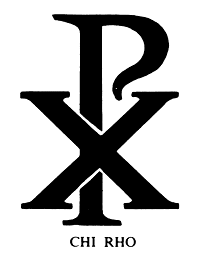
From her who I wish to free, steams of perfume that impregnated the
sepulcher climbed towards me. Formerly some called her ISIS, queen
of the beneficial spring, COME TO ME ALL OF YOU WHO SUFFER AND WHO
ARE AFFLICTED, AND I WILL COMFORT YOU. For others: MADGALENE, of the
famous vase full of healing balm. The initiates know her true name:
OUR LADY OF THE CROSS.
Here the author associates Isis,
Venus, Virgo, and Mary Magdalene
with the vase full of balm which all of these characters were
supposed to have carried, and which can also be linked with the Holy
Grail. The use of the term “Our Lady of the Cross” again associates
the goddess with the Celtic circle and cross symbol. The idea that
she needs to be “freed” from something indicates that she, like her
brothers, the Cainites, is imprisoned within her mountain tomb,
trapped “in a deathless sleep”, like Sleeping Beauty.
I was like the shepherds of the famous painter POUSSIN, perplexed in
front of the enigma: “ET IN ARCADIA EGO…”!
It goes without saying that this is a reference to
Nicolas Poussin’s
painting, The Shepherds of Arcadia, which was mentioned in the Sauniere parchments, and which depicts the mountains of
Rennes-le-Chateau. The painting is a clue indicating the sacred
tombs located within the mountains.
|
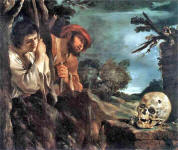
Et in
Arcadia Ego, Guercino |
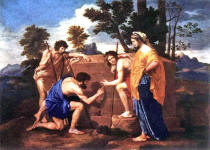
Et in
Arcadia Ego, Poussin |
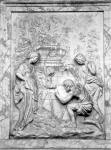
Shepherd's Monument |
The voice of the blood made me form an image of an ancestral past.
Yes, the lightening flash of genius cut across my thinking. I saw it
again, I understood! I knew now this fabulous secret.
The author is perhaps experiencing ancestral memories pertaining to
the secret of the Grail, for he may be of the Grail blood himself.
One must marvel that, during the jumps of the four horsemen, the
hooves of one horse left four imprints on the stone.
The imagery of horses brings to mind the “horse of God” that was
mentioned in the Sauniere parchments. However, these “four horsemen”
are the four knights on the chessboard, and their “jumps” are once
again a reference to the Knight’s Tour. They are also reminiscent of
the four horsemen of The Revelation of Saint John the Divine.
There is the sign that DELACROIX had given in one of three tableaus
in the Chapel of Angels. There is the seventh sentence that a hand
had traced: DELIVER ME FROM THE MIRE, SO THAT I WILL NOT STAY HERE
SINKING. Twice IS, embalmer and embalmed, miracle vase of the
eternal White Lady of the Legends.
“Twice IS” is, of course,
Isis, or Venus, the “Eternal White Lady of
the Legends.” Here, her vase is associated with the embalming of
corpses, both her own and someone else’s. Of course, Mary
Magdalene’s balm was supposedly used to “anoint” Jesus for burial.
“Deliver me from the mire” is perhaps a prayer from the Ark
navigator, asking to be saved from the Flood, to keep him from
sinking into the mud that was swallowing up creation all around him.
It also may link up with the story of the children of God, Shu and
Tefnut, who in Egyptian mythology got lost in the Primeval Waters,
and were saved by God’s eye, which was sent out to find them. In the
myth, the Eye was personified as female, a precursor to the idea of
the goddess Isis.
Begun in darkness, my journey could only be completed in Light.
Here is yet another reference to the opposing but equal powers of
good and evil, light and dark.
At the window of the ruined house, I contemplated the trees made
bare by the autumn.
This “ruined house”, like the story of the ruined Temple of Solomon,
or the ruined Tower of Babel, represents the loss of the Grail
wisdom after the Deluge.
At the summit of the mountain, the cross detached itself from the
crest under the midday sun. It was the fourteenth and highest of all
with 35 centimeters!
I have already discussed the significance of the
time of midday, or
high noon, in regards to the Rennes-le-Chateau mystery in other
Dagobert’s Revenge articles, and in my book
The Merovingian Mythos
and the Mystery of Rennes-le-Chateau.
It is the moment when Hiram Abiff (representing the dead, hidden god
within the tomb) was murdered.
Dagobert II, to whom the treasure of
Rennes-le-Chateau is said to belong, was also murdered at midday,
and “midday” is mentioned specifically in the parchments found by Sauniere. As for the rest of this passage, I have been unable thus
far to decipher it conclusively.
Here I am, thus, on my knight’s tour, on the circuit of the divine
horsemen of the abyss.
Here is an even more overt reference to the Knight’s Tour. The words
“divine horsemen” would also seem to correlate with the “horse of
God” reference in Sauniere’s second parchment. “Crossing the Abyss”
may be analogous to discovering the tomb, and “reassembling the
scattered stones” – regaining the Grail.
Celestial vision for him who remembers the four works of E. M.
Signol regarding the meridian line;
Emile Signol was a painter who produced four paintings of the old
Paris meridian line, which the Priory documents suggest has some
geometric relationship to the “Roseline” meridian. Signol also
painted a famous portrait of King Dagobert II. All of these works
are now on display in the Saint Sulpice church in Paris.
…at the choir of the sanctuary from where this spring of love
radiates towards one another, I pivot, looking from the rose from P
to that of the S, then from the S to the P…
I believe this line refers to the
tombs hidden beneath the mountains
of Rennes-le-Chateau: the “sanctuary.” The word “choir” comes from
“core”, indicating the inner chamber of that structure, the “heart
of the sanctuary.” The word “heart” in French, is “coeur”, and it
comes from the Latin “cor” or “cordis”, from whence we get the word
“cardia”, designating the heart organ These words are also related
to the ancient words “kar” and “gar”, the key syllables in the words
“Garral”, or “Grail”, and “Kardo”, the name given in The Book of the
Cave of Treasures for the mountain upon which the Ark landed, which
I have equated with Mt. Cardou in Rennes-le-Chateau. In my book The
Merovingian Mythos I discuss how Cardou/Kardo may have been, as
indicated by the Priory of Sion’s own writings, the “zero point” for
the ancient prime meridian referred to by the Priory as the
“Roseline”, and thus was literally the “center of the Earth” in
ancient times.
The “rose” mentioned may be the “hidden sun” said to be within the
tomb, which is referred to metaphorically in occult ritual as a
rose. It may represent, in this instance, the “heart” of Mt. Cardou.
If the prime meridian of the ancient world passes through this
point, this may explain why it is called “the Roseline.” The
reference to the “heart” which “radiates the source of love for one
another” identifies this “rose” with the Sacred Heart symbol as
well, which was used by the
Priory of Sion under their guise as
the Hieron du Val d’Or. The Sacred Heart symbol is further linked with
the rose-cross, the Celtic cross, the ankh, and the Venus symbol.
All of these represent this concept of the center of the Earth and
the prime meridian.
The “P” and “S” represent the
Priory of Sion.
…and the spiral in my mind becomes like a monstrous octopus
expelling its ink. The tentacles absorb the light, I am dizzy.
The tomb of Marie de Blanchefort, which in its inscription reveals
the coded words “Et in Arcadia Ego”, also has the figure of an
octopus etched down at the bottom. The octopus is, according to
Priory of Sion member Paul Le Cour, a solar symbol used in Atlantis.
It also contains the same symbolism as Arachne, the spider goddess,
in regards to the number eight and the chessboard.
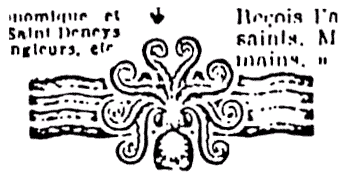
“The spiral in my mind” may signify the
Fibonacci spiral. On the
tombstone of Marie de Blanchefort, at the top, we find the letters
P
and S, linked by a Fibonacci spiral. Furthermore, when an octopus
expels ink into water, the ink makes a perfect Fibonacci spiral,
another peculiar property of nature. Spirals in general, however,
can also be seen as yet another representation of the labyrinth, or
maze.
I put my hand to my mouth, instinctively biting my palm, maybe like
OLIER in his coffin.
This is the Masonic “Sign of Horror”, made by raising the hand over
the mouth and biting the palm, a perfectly apt sign to be made if,
for instance, one has just discovered a tomb. In fact, this sign is
used in Masonic ritual when reenacting the discovery of Hiram Abiff’s tomb.
Jean-Jacques Olier was the founder of the Seminary of
Saint Sulpice. “Olier in his coffin” may just be a reinforcement of
the image of the divine tombs, and the involvement of the Priory of
Sion in the Rennes-le-Chateau mystery.
Curses, I understand the truth, HE HAS PASSED in doing good, as did
he of the flowery tomb.
“He has passed” is reminiscent of the phrase “he is there dead” from
the Sauniere parchments (below) which in that case referred to the remains
of King Dagobert being buried at Rennes-le-Chateau. These bones were
probably laid there alongside those of his ancestors, going all the
way back to the Cainites. The “flowery tomb” reference is in regards
to the supposed “rose (or “hidden sun”) within the tomb of
Enoch/Hermes.
|
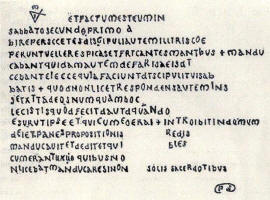 |
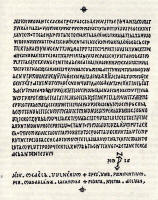 |
|
THE 'DAGOBERT' PARCHMENT
The text on this parchment, the shorter of the two,
is a composite of different Gospel accounts of
Jesus and his disciples eating corn on the
Sabbath. The hidden message was discovered by Henry
Lincoln in 1969. Some of the letters are raised
above the rest on the line, and simply reading them
in order gives the words:
A DAGOBERT II ROI ET A SION EST CE TRESOR ET IL EST
LA MORT |
THE 'SHEPHERDESS' PARCHMENT
This had attracted by far the more interest and
attempts at interpretation.
The Latin text is the account from John's Gospel
(chapter 12) in which Mary of Bethany (believed by
many to be one and the same as Mary Magdalene)
anoints Jesus. As with the first parchment,
certain letters are picked out - this time by being
smaller than the rest - which spell the words REX
MUNDI, Latin for 'King of the World', a term used by
Gnostic heretics such as the Cathars. |
There is a grave in the church graveyard at
Rennes-le-Bains which
appears to links up with this line as well - or rather, two graves.
For in this yard there are two gravestones bearing the name of
Paul-Urbain de Fleury, grandson of Marie de Blanchefort.(6)
Henry
Lincoln believes that the reason for the gravestone duplication is
to draw attention to the man’s name, which sounds a lot like
“fleurie”, the French word for “flowery.”
But how many have plundered the HOUSE, leaving nothing but embalmed
cadavers and metal objects that they could not have taken. What
strange mystery is concealed within the new temple of SOLOMON,
edified by the children of Saint VINCENT?
This is clearly a reference to the sacking of Solomon’s Temple, the
loss of the Grail, and the “ruined house” concept discussed earlier.
The “new” Temple of Solomon reference alludes to the concept of
regaining that which was lost. But it may also refer to
Rennes-le-Chateau, linking it symbolically with the Temple of
Solomon. In other words, Rennes-le-Chateau is the real “Holy of
Holies”, where the real “stone from Heaven”, and the bodies of the
real “holy patriarchs” are buried: the real “center of the Earth”,
and the ideal location to build a sacred temple, which I believe
also exists within the mountains. The writer seems to be describing
a tomb that has been partially plundered except for the bodies, and
other objects that were too heavy to carry. This may indeed be the
case with the tombs beneath Rennes-le-Chateau.
The “Children of Saint Vincent”
are a subsection of the Priory of Sion mentioned in the statutes written for the order by
Jean
Cocteau, who, according to him, number 243, and who “participate
neither in the vote, nor in the Convents, but to whom the Priory of Sion accords certain rights and privileges.” This subgroup was
created, Cocteau claimed, on January 17, 1681.
Cursing the profaners in their ashes and those who follow their
ways, I leave the abyss where I was plunged while making the gesture
of horror.
Here we have another reference to the Masonic “Sign of Horror” upon
discovering a tomb. The “profaners” are those who have plundered the
tombs.
Here is the proof that I knew the secret of the Seal of Solomon, and
that I had visited the hidden houses of this queen.
Another reference to the six-pointed star, and to the “Sleeping
Beauty” hidden inside of a mountain.
Take heed, dear Friend. Do not add or remove one iota; think and
think again.
This indicates that clues are hidden in the precise wording of this
poem, which you will understand more clearly every time you examine
it. These are very similar words to those used at the end of The
Revelation of Saint John the Divine, which may not, in fact, be that
last words of that book in its original form. A rumor persists that
the Priory of Sion (and, I suspect, specifically Jean Cocteau) was
in possession of a twenty-third chapter to The Revelation of Saint
John the Divine that contained unknown secrets about the Apocalypse
which
the Vatican wished to remain secret. This theory is presented
in Andre Douzet’s book Sauniere’s Model and the Secret of
Rennes-le-Chateau, in which he links it to the mysterious phrase
“John 23” uttered by Berenger Sauniere at his death. Just a few
years later, Jean Cocteau assumed the title “John 23”
when he took office as the Grand Master of the Priory.(7)
The base lead of my writing contains the purest gold.
These words imply that the tomb which the poem describes contains
the secrets of alchemy, which it would if it contained the
tablet of
Enoch (Hermes-Thoth).
Returning to the white hill, the sky has opened its floodgates.
In the Bible, the “floodgates” of the “firmament of Heaven” were
opened to let loose the catastrophic Deluge.
There seemed to be a presence nearby, its feet in the water like him
who comes to receive the mark of baptism.
Following the Flood reference, here we have yet another reference to
water, specifically baptism. This could symbolize the cleansing of
the Earth via the Flood. It could also refer in part to Christ’s
baptism by John the Baptist. In those days, the ritual was performed
not by an emersion of the entire body, but only the feet. Note that
Jean Cocteau’s mural at Notre Dame de France in London shows only
the feet of Christ. But there is another mural of Cocteau’s that
illustrates this principle even more clearly. It is the mural in the
Chapel of Saint Peter entitled Saint Peter Walking on Water. The
painting shows Peter being held aloft by an angel while his feet are
dipped into the water, as though he were being baptized.
I turn again towards the East. Facing me I see rings unrolling
without end, the enormous SERPENT ROUGE cited in the parchments.
Salty and bitter, the enormous unchained beast became, at the feet
of this white mountain, red in color.
This passage could conceal a
hidden message regarding the
combination of red and white powders in alchemy. The reference to
the snake being “bitter” reinforces the association with the
sulfurous red element used in that process.
My emotions were rising. “Deliver me from the mire!”, I said, and
awoke immediately. My dream is over. I have omitted from telling you
in effect that this was a dream I had this JANUARY 17th, feast day
of Saint SULPICE.
January 17, as we know, is a date that recurs frequently in this
Rennes-le-Chateau mystery. It is the day Marie de Blanchefort is
recorded to have died, and the date on which Berenger Sauniere fell
ill with a stroke, from which he died five days later. It is also
the date on which Nicolas Flamel, one of the Grand Masters of the
Priory of Sion, is recorded to have successfully completed his first
alchemical transformation of base metal into gold, and the date upon
which the Priory of Sion‘s “Children of Saint Vincent“ were created.
Furthermore, it is, as the poem notes, the Feast Day of Saint Sulpice, and we know that the
Priory of Sion took headquarters in
the Seminary of Saint Sulpice for some time.
Recently I have discovered even more interesting connections
regarding this date. The Birthday Book of Saints, by Sean Kelly and
Rosemary Rogers, says that January 17th is also the feast day of
St.
Anthony the Hermit, the patron saint of buried treasure has cropped
up elsewhere in the Rennes-le-Chateau mystery. But even more
astounding is that, in addition, this date marks the feast day of
“St. Roseline”, whose name contains an obvious connection to the
“Roseline” meridian (which, incidentally, runs through St. Sulpice
in Paris). According to Kelly and Rogers, she was:
“… the mind reading prioress of Provence. When she was exhumed in
1334, four years after her death, her body was perfectly incorrupt.
The astonished cleric in charge was so impressed by the beauty of
her eyes that he scooped them out and took them home.”
The details of this story clearly mimic the
legend of Venus lying
incorrupt within her tomb. The bit about the eyes being taken out
connects with the idea of
the “Watchers”, and with the story of the
missing eye of Horus.
Afterwards, my trouble persisting, I wanted after some reflection to
tell you a fairytale by PERRAULT.
Charles Perrault, a seventeenth century French writer and poet, was
the author of the book Sleeping Beauty.
Here then, dear reader, in the pages that follow are the result of a
dream that cradled me in the world of the strange and the unknown.
To him who PASSES BY, DO GOOD!
Here the writer seems to be suggesting that we use the clues
embedded in the poem to explore the “world of the strange and the
unknown”, and to “do good” by solving the mysteries of the Grail,
and of Rennes-le-Chateau.
There are many riddles still left to be solved within this poem.
This may form the basis for a forthcoming book on the subject.